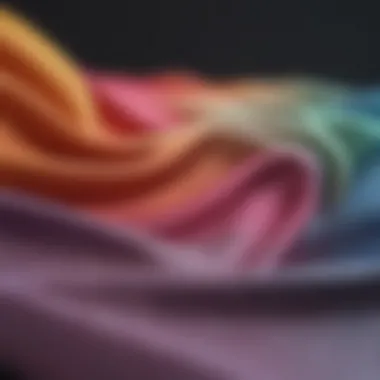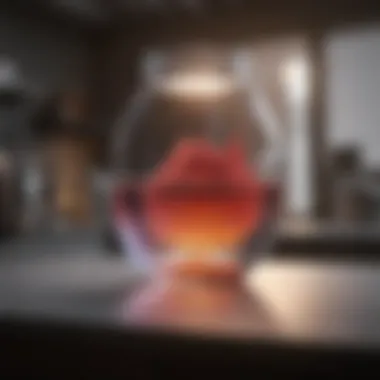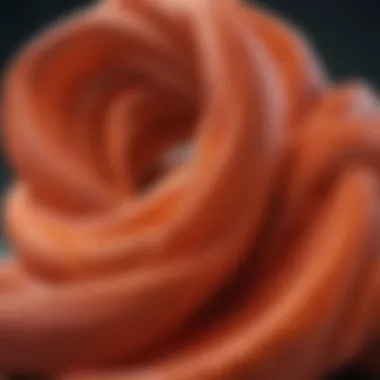Exploring Thermochromic Fabric: Innovations and Applications


Intro
The emergence of thermochromic fabric presents unique possibilities within textile innovation. This material's ability to change color in response to temperature fluctuations adds an exciting dimension to both artistic expression and practical utility. Historically, textiles have remained relatively static in their visual appeal. However, with the advent of thermochromic technology, a new era begins, where clothing and fabrics can react to their environment dynamically.
As industries explore the applications of this memorable textile, understanding its core functionality and the science behind it is essential. Thermochromic materials rely on specific chemical substances, such as leuco dyes, which transition between states when temperatures change. The spectrum of color possibilities lends itself to numerous uses, from fashion design to safety gear. Therefore, delving into the fundamentals, innovations, and implications of this technology becomes a necessary endeavor for students, researchers, educators, and professionals alike.
Research Highlights
Overview of Key Findings
The findings surrounding thermochromic fabric reveal its challenging yet beneficial performance characteristics. Recent studies show that different compositions yield varying response rates to temperature changes. Materials like hydrochromic or photochromic additives can enhance the fabric's versatility, thus broadening the applications. Key areas of research include:
- Synthesis Techniques: Advanced methods for creating thermochromic pigments that respond to temperature variations efficiently.
- Durability Assessment: Testing material longevity under repetitive cycles of temperature change.
- Environmental Effects: Evaluating the ecological footprint of production processes.
Significance of the Research
This research carries significant implications. The ability of fabrics to indicate temperature changes can serve various sectors. For instance, wearables in sports could enhance performance monitoring, while temperature-sensitive textiles used in medical fields could improve safety.
Moreover, as sustainability becomes a pressing concern, the study of thermochromic materials encourages exploration into eco-friendly manufacturing processes. Understanding and improving their environmental impact may lead to a more sustainable approach in textile production.
Future Directions
As thermochromic technologies advance, further research is necessary to:
- Refine synthesis processes for better quality and reaction time.
- Explore new markets and applications for these textiles.
- Assess integration with other smart materials for multifunctional capabilities.
Thermochromic fabric has the potential to transform industries by providing innovative solutions that adapt to users' needs. As research progresses, more creative applications will undoubtedly emerge, fostering a new appreciation for smart textiles in everyday living.
"Incorporating thermochromic technology into fabric not only enhances functionality but also invites a new wave of creativity."
Clearly, the landscape of textiles is changing. By tapping into the transformative potential of thermochromic fabric, the vision for the future of textiles expands significantly.
Intro to Thermochromic Fabric
Thermochromic fabric is an innovative material that dynamically responds to temperature changes by altering its color. This fascinating characteristic presents numerous possibilities for various applications in fashion, safety, and design. Understanding thermochromic fabric is crucial not only for the textile industry but also for anyone interested in the intersections of science, technology, and art. The main aim of this section is to explore the definition and historical background of thermochromic fabric, which lays the groundwork for its current and future significance.
Definition and Characteristics
Thermochromic fabrics are made using special dyes or pigments that change color at specific temperature thresholds. These materials leverage thermochromism, the property that makes them sensitive to temperature shifts. The color change can signal a variety of states, from temperature alerts to aesthetic enhancements in clothing.
Key characteristics include:
- Temperature Sensitivity: Different types of thermochromic materials react at varying temperatures, making them customizable for specific applications.
- Reversibility: Many thermochromic fabrics can revert to their original color once the temperature returns to normal, thus emphasizing their functionality.
- Durability: With advancements in technology, manufacturers have worked to improve the longevity and reliability of these fabrics.
Each of these traits opens up opportunities and challenges in applications across multiple fields.
Historical Development
The journey of thermochromic fabric has seen significant progress over the years. It traces back to the exploration of thermochromism in the 1970s when researchers identified specific compounds that change color under heat exposure. The early applications were primarily in novelty items. As technology in dye chemistry evolved, the interest in applying these principles to textiles surged in the 1990s.
With increasing demand for functional and interactive clothing, designers began to incorporate thermochromic elements into fashion. High-profile brands like Adidas and Puma utilized these materials to create unique products that blend technology and aesthetics. As more industries recognize the potential of thermochromic fabrics, the evolution continues, paving the way for further innovations and applications.
"Innovations in textile technology are not just about looks; they also enhance functionality and user experience."
The Science of Color Change
The topic of color change in thermochromic materials is fundamental for understanding how these fabrics function and their diverse applications. Color change is not just a visual effect; it involves complex interactions between temperature and material properties. As temperatures fluctuate, thermochromic fabrics respond in distinct ways, altering their appearance according to the surrounding environment. This dynamic property opens up a vast range of possibilities across multiple industries, from fashion to technology.
Mechanisms Behind Thermochromism


Thermochromism is the phenomenon where materials change color when subjected to temperature variations. The underlying mechanisms are primarily linked to the structural and chemical characteristics of the dyes used in these fabrics. When heat is applied, certain molecules within the dye can undergo a structural change, leading to a different light absorption profile. This can result in a shift in color. The precision of thermochromic materials lies in their chemical formulation, often incorporating compounds that react in predictable ways to specific temperature ranges. These reactions often depend on molecular rearrangements or phase transitions, highlighting the interplay between heat energy and molecular dynamics.
Types of Thermochromic Dyes
Various types of thermochromic dyes exhibit unique properties, each contributing to the overall performance of thermochromic fabrics.
Leuco Dyes
Leuco dyes are notable for their ability to switch from one color to another. When heated, these dyes can transition between a colored and a colorless form, depending on the temperature. The key characteristic of leuco dyes is their reversibility, allowing them to return to their original state upon cooling. This quality makes them a popular choice, particularly in textiles that require repeated functionality without degradation.
However, leuco dyes also have limitations. Their sensitivity to light and humidity can impact longevity and stability in some applications. This balance between functionality and environmental sensitivity is a crucial consideration in their use in thermochromic fabric.
Photochromic Dyes
Photochromic dyes also serve an essential role in thermochromic applications, although they primarily react to light rather than temperature. When exposed to ultraviolet (UV) light, these dyes undergo a structural change that alters their color, making them useful in scenarios where light interaction is significant. The key characteristic of photochromic dyes is their ability to provide another layer of functionality alongside temperature responsiveness.
Despite their advantages, photochromic dyes can become less effective over time with excessive light exposure. They may not be suitable for constant use in sunlight, making them a less desirable option in some textile applications.
Liquid Crystal Technologies
Liquid crystal technologies represent a more sophisticated approach to thermochromic fabric. Unlike traditional dyes, these materials utilize liquid crystalline properties that change their alignment in response to temperature shifts, thus affecting how light is refracted and the perceived color.
The key feature of liquid crystal technologies is their ability to create vibrant color changes that can be more finely tuned than conventional dyes. This results in enhanced versatility, enabling designers to think outside the box with their fabric applications. However, the complexity and cost of incorporating liquid crystals into textiles can present challenges, making it less accessible compared to simpler dyeing methods.
Liquid crystal technologies offer a sophisticated solution for dynamic color change, pushing the boundaries of what thermochromic fabrics can achieve.
Synthesis of Thermochromic Materials
The synthesis of thermochromic materials is crucial for the development and functionality of thermochromic fabrics. Understanding these synthesis processes allows for the creation of materials that respond dynamically to temperature changes. This section will cover both the chemical processes involved and the role of nanotechnology in enhancing thermochromic materials.
Chemical Processes Involved
The synthesis of thermochromic materials involves several chemical processes. The primary mechanism centers on the use of dyes that change structure in response to temperature fluctuations. Leuco dyes are frequently deployed in this synthesis. These dyes exist in two forms: a colorless form at lower temperatures and a colored state when the temperature rises. When synthesized correctly, these dyes can be effectively integrated into fabric, providing the desired thermochromic effect.
Key considerations in the chemical synthesis include:
- Temperature Sensitivity: The precise temperature at which color change occurs.
- Color Stability: How well the color change holds over time and through multiple cycles.
- Environmental Reactivity: The response of the materials to various environmental conditions.
The processes might include:
- Polymerization: This is where monomers are chemically bonded to form a polymer matrix, which can embed the thermochromic dyes.
- Microencapsulation: This technique protects the dyes, ensuring they remain stable during manufacturing and use.
Nanotechnology in Thermochromics
Nanotechnology plays a pivotal role in advancing the synthesis of thermochromic materials. The incorporation of nanostructured components can enhance the performance of these materials. By manipulating materials on a nanoscale, manufacturers can achieve better control over properties such as color change speed and durability.
Key aspects of nanotechnology in thermochromics include:
- Enhanced Responsiveness: Nanoparticles can improve the rate at which thermal stimuli lead to color change, ensuring quicker reactions to temperature variations.
- Improved Durability: The nanoscale structure often offers greater resistance to degradation, prolonging the lifespan of thermochromic applications.
- Versatile Applications: Nanosized materials can be engineered to achieve specific effects, broadening the potential uses in fashion, industrial applications, and safety products.
The combinations of innovative chemical processes and nanotechnology represent a significant leap forward in the field of thermochromic fabric synthesis, promoting broader applications and more reliable performance.
Applications of Thermochromic Fabric
The applications of thermochromic fabric are vast and diverse, demonstrating its versatility across several industries. This topic is crucial as it showcases how these innovative materials can be utilized in fashion, interior design, and safety technologies. Each sector benefits from the unique properties of thermochromic fabrics, which not only provide aesthetic appeal but also enhance functionality.
Fashion and Apparel
Thermochromic fabric has made significant inroads in the fashion industry. Designers are increasingly turning to these materials to create garments that change color with temperature shifts. This not only captures attention but also allows wearers to express their individuality through changing styles.


Thermochromic prints can respond to body heat or environmental changes, enabling items like dresses and shirts that can appear to have different hues. This can add a dynamic element to fashion shows and everyday wear, creating a sense of novelty and innovation.
"The use of thermochromic materials in fashion allows for dynamic expressions of personal style."
Moreover, these fabrics can provide practical benefits. For instance, they can signal temperature changes which may indicate when a garment is getting too hot. This can be particularly useful in performance or outdoor clothing, where temperature management is essential for comfort and functionality.
Interior Design
In interior design, thermochromic fabrics have opened up new avenues for creativity. From curtains to upholstered furniture, these materials can enhance living spaces by changing color based on temperature. This transformation contributes to the aesthetic appeal of a room while providing a unique sensory experience.
Using thermochromic materials can also serve practical purposes within the home. For example, temperature-sensitive fabrics in shades that respond to sunlight can help in maintaining the ambiance of a room. Effective use of these fabrics can lead to energy savings by reducing the need for artificial lighting during the day. Moreover, they act as an indicator, reflecting the warmth of a room, which can guide users in managing their heating systems efficiently.
Safety and Wearable Technology
The intersection of thermochromic fabric and safety is compelling. These materials can be integrated into wearable technology to enhance safety features. For instance, clothing made with thermochromic fabric can change color to signify overheating. This could be critical for workers in high-risk environments.
Similarly, in the realm of sports, thermochromic fabrics can serve as a visual alert for overexertion or heat stress. Athletes can benefit from real-time feedback about their body temperature through color changes in their gear. This could potentially aid in injury prevention, making these fabrics not only fashionable but essential for physical well-being.
Environmental Impact and Sustainability
The discussion surrounding thermochromic fabric must include its environmental impact and sustainability. As modern consumers become increasingly aware of the ecological footprint of their choices, textiles must adapt to meet these expectations. Thermochromic fabrics not only offer innovative functionalities but also present significant considerations regarding sustainability. The production, use, and disposal of these materials can have lasting implications for the environment.
Biodegradable Alternatives
The textile industry has a notorious reputation for generating waste and using non-renewable resources. To address these concerns, researchers are exploring biodegradable alternatives for thermochromic materials. Developing fabrics that can decompose naturally offers a promising solution to the environmental impact.
While traditional thermochromic dyes often utilize plastic substrates that do not break down easily, newer formulations focus on organic compounds. These alternatives can include plant-based materials that not only provide color-changing properties but can also dissolve over time without leaving harmful residues.
Some of the biodegradable options currently being explored involve the integration of natural polymers, such as chitosan or polylactic acid (PLA). These materials can be modified to achieve thermochromic effects while ensuring they do not persist in landfills for decades.
Lifecycle Assessment of Thermochromic Fabrics
Lifecycle assessment (LCA) serves as a crucial tool in evaluating the environmental impact of thermochromic fabrics. By analyzing each stage of a product's life—from raw material extraction through manufacturing, usage, and end-of-life disposal—stakeholders can uncover opportunities for improvement in environmental performance.
Key elements of LCA include:
- Raw Material Sourcing: Assess the ecological consequences of extracting and processing materials used in thermochromic dyes and substrates.
- Manufacturing Impact: Evaluate energy consumption and emissions produced during the production process.
- Usage Phase: Investigate the durability and functionality of thermochromic fabrics, as frequent replacements can contribute to waste.
- Disposal Methods: Consider the end-of-life options for these materials, whether they are recyclable, biodegradable, or contribute to landfill waste.
By applying these elements in assessing thermochromic fabrics, researchers can identify not only the environmental burdens but also how innovations in material science may reduce negative impacts.
"Understanding the lifecycle of thermochromic fabrics is essential for creating a sustainable future in the textile industry."
The awareness of environmental impacts associated with textile choices can lead to more informed consumer decisions. This understanding is vital for developing responsible production methods and finding sustainable alternatives in the thermochromic domain.
Consumer Reception and Market Trends
The understanding of consumer reception and market trends is vital for gauging the success and future prospects of thermochromic fabric. This segment reveals how these textiles are perceived across various industries, particularly in fashion and technology. By examining patterns of acceptance and interest among consumers, stakeholders can better strategize marketing and product development. Furthermore, the trends reflect the broader societal shifts towards functional and innovative materials that enhance not only aesthetic value but also practicality.
Popularity in Fashion Circles
Thermochromic fabric has found a remarkable niche within fashion circles, drawing admiration from designers and consumers alike. Designers leverage the unique color-changing properties of this material to create dynamic clothing. Collections that utilize thermochromic elements often garner media attention and consumer interest. The allure of garments that react to body heat or environmental temperatures adds an unprecedented layer of interaction in fashion.
In this context, several factors influence its popularity:
- Trendsetting Design: Designers use thermochromic textiles to stand out in a crowded marketplace. The novelty allows for creativity that captivates the modern consumer.
- Experiential Shopping: Shoppers today seek unique experiences. Thermochromic fabric aligns perfectly with this demand, offering an engaging and interactive element to garments.
- Celebrity Influence: The promotion of thermochromic pieces by influencers and celebrities increases buzz and desirability.
To sum up, the fashion industry embraces thermochromic fabric not merely as a trend, but as a revolutionary tool that infuses technology with tradition.
"The intersection of technology and fabric showcases the endless possibilities of modern design, particularly in functional textiles like thermochromics."


Consumer Awareness of Functional Textiles
As thermochromic fabric enters mainstream markets, awareness among consumers about functional textiles is growing. Education around how these fabrics work and their benefits is essential for driving demand. Consumers are increasingly knowledgeable about different textile functionalities. They are not just passive recipients; they actively seek information about sustainability, care, and durability.
Key elements of consumer awareness involve:
- Understanding Benefits: Consumers learn that thermochromic fabrics can change color based on temperature, influencing their comfort and fashion choices.
- Sustainability Concerns: With a rise in eco-consciousness, awareness about the environmental impact of textiles plays a crucial role. Market trends show that consumers prefer products that are sustainable and environmentally friendly.
- Accessibility of Information: The internet provides platforms for sharing knowledge, such as Reddit and various online forums. This assists in demystifying advanced textiles and making them more relatable.
By fostering awareness regarding the functional aspects of thermochromic fabric, manufacturers can tap into growing consumer interests, aligning product offerings with market demands.
Challenges in Thermochromic Fabric Development
The development of thermochromic fabric presents unique challenges that must be addressed to realize its full potential. This section outlines critical aspects affecting the advancement of these innovative materials. Understanding these challenges is essential, as they can directly impact the performance, marketability, and longevity of thermochromic fabrics in various applications.
Durability and Longevity
Durability is a significant factor when considering thermochromic fabrics. Due to their color-changing properties, these materials can be sensitive to environmental conditions. The chemical compounds used in thermochromic dyes may degrade when exposed to UV light, consistent wear, or harsh washing methods. This degradation can lead to fading colors or even a complete loss of functionality. As a result, manufacturers need to invest time and resources into finding solutions that enhance the material's durability.
To ensure longevity, testing procedures need to be robust. The performance of thermochromic fabrics must be evaluated under various stress conditions, including extreme temperatures, moisture, and physical wear. Experts suggest developing guidelines for washing and handling to prolong the life of these fabrics.
Cost-Effectiveness in Manufacturing
Manufacturing thermochromic fabric is often more complex than conventional textiles. The need for specialized materials and production processes can significantly increase costs. Labor and expertise required to handle and apply thermochromic dyes add another layer of expense. This raises a critical question: how can manufacturers produce high-quality thermochromic textiles while remaining competitive?
Finding cost-effective solutions is vital. This can include researching new synthesis methods or exploring alternatives to current dyes. Collaboration with chemists and material scientists can lead to innovations that not only enhance performance but also reduce manufacturing costs. Additionally, developments in automated systems and processes can contribute to making thermochromic fabric more affordable for widespread use.
Identifying and resolving challenges like durability and cost-effectiveness will greatly advance the development of thermochromic fabrics.
In summary, addressing durability and longevity, as well as manufacturing costs, remains critical for the progress of thermochromic fabric technology. By focusing on these aspects, the industry can better equip itself to meet the demands of consumers and industries that seek to utilize these innovative materials.
Future Directions in Thermochromic Research
The realm of thermochromic fabric is continually evolving. Innovations in material science and various potential applications are critical to ensuring the longevity and relevance of thermochromic technology. As industries explore new methods of integrating these materials, it is essential to consider the advancements that will shape the future landscape of textiles. The intersection of functionality and aesthetic appeal can lead to groundbreaking developments.
Innovations in Material Science
Material science plays a pivotal role in the future of thermochromic fabrics. Researchers are experimenting with novel approaches to enhance the performance and versatility of thermochromic dyes. By delving into nanotechnology, scientists can create smaller, more efficient particles that respond to temperature changes more rapidly and uniformly. These advancements promise improved accuracy in color changes, offering users more predictable experiences.
Moreover, combining thermochromic properties with other functional materials can yield hybrid fabrics that serve multiple purposes. For instance, integrating thermochromic dyes with moisture-wicking properties could lead to garments that not only change color with temperature but also adapt to levels of physical exertion. Such innovations could redefine performance apparel in the sporting and fashion industries.
Potential New Applications
The potential applications of thermochromic fabrics extend far beyond the traditional scope of fashion and interior design. Industries such as healthcare could leverage these materials for innovative diagnostic tools. For example, clothing embedded with thermochromic properties may indicate body temperature changes, thereby offering real-time health monitoring.
In addition to healthcare, the automotive industry shows promise for thermochromic fabrics. Imagine car interiors that adapt to temperature changes without the need for air conditioning. Such features would not only enhance comfort but also contribute to energy efficiency.
"Thermochromic materials hold the key to creating textiles that respond dynamically to environmental changes, opening doors to uncharted territories in various industries."
As technology progresses, thermochromic fabric could also find applications in sectors like smart home systems. Imagine curtains or upholstery that alter color according to sunlight exposure, providing not only aesthetic appeal but also contributing to energy savings through temperature regulation.
The future of thermochromic research hinges on how effectively scientists and manufacturers can address challenges such as durability and cost-effectiveness while pushing the boundaries of innovation in materials science. By fostering collaboration across disciplines, the potential for thermochromic fabric is immense, setting the stage for revolutionary applications that will define the next generation of textiles.
Finale
The conclusion serves as a critical aspect of the discourse on thermochromic fabric, neatly encapsulating the insights and reflections discussed throughout the article. This section highlights the significance of thermochromic materials and their potential impact on various industries. By revisiting the key points, it offers an opportunity for the audience to see the broader relevance of these innovations. Understanding the implications of thermochromic technology is essential not only for its current applications but also for future advancements.
Thermochromic fabric has transformed the textile landscape, combining both aesthetic qualities and incredible functionality. This dual benefit is notable in fields such as fashion, where changing colors based on temperature can enhance the visual experience for the wearer. It also allows for practical applications in safety gear, where visibility may become crucial under varying environmental conditions.
The discussion on sustainability brings attention to how these fabrics impact the environment, emphasizing the need for biodegradable alternatives. Designers and manufacturers need to consider how these innovative fabrics can coexist with the ecological considerations of our time. Thus, the conclusion reinforces the relationship between technical progression and sustainable practices.
"Innovations in thermochromic fabric stand to not only redefine the aesthetics but also reshape functionalities in vast sectors."
Summary of Key Points
- Thermochromic fabric changes color due to temperature changes, merging science with textiles.
- Innovations in this field span across multiple industries, from fashion to safety applications.
- The environmental impact poses challenges that necessitate thoughtful solutions, highlighting the importance of sustainability.
- Awareness of consumer preferences plays a crucial role in the development of thermochromic technologies, influencing market trends.







